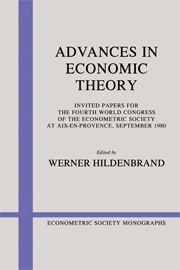Book contents
- Frontmatter
- Part I Economics of incentives
- Part II Information and the market mechanism
- Part III Non-Walrasian economics
- Chapter 4 Developments in non-Walrasian economics and the microeconomic foundations of macroeconomics
- Chapter 5 On equilibria with rationing
- Part IV Repeated games
- Part V Topics in competitive analysis
- Part VI Applied macroeconomics
- Part VI Industrial organization
Chapter 5 - On equilibria with rationing
from Part III - Non-Walrasian economics
Published online by Cambridge University Press: 05 January 2013
- Frontmatter
- Part I Economics of incentives
- Part II Information and the market mechanism
- Part III Non-Walrasian economics
- Chapter 4 Developments in non-Walrasian economics and the microeconomic foundations of macroeconomics
- Chapter 5 On equilibria with rationing
- Part IV Repeated games
- Part V Topics in competitive analysis
- Part VI Applied macroeconomics
- Part VI Industrial organization
Summary
The literature about the so-called equilibria with rationing is one attempt (among many) to tackle questions that arise at levels that can be categorized for analytical convenience.
On one hand, there has been some discomfort with the way in which competitive Walrasian equilibrium is formulated classically. The classical definition does not depict any relations among economic units and, consequently, there is an unknown of the system (the equilibrium price vector) that is not chosen by any agent. Alternatively, one of the first proofs of the existence of a competitive Walrasian Equilibrium (Arrow and Debreu, 1954) reduces an economy with m agents to a game in normal form with m + 1 agents, the last one of which is the auctioneer whose role is to choose the price vector. This provides a centralized version of Walrasian competitive equilibria (WCE). Clearly, the theorem regarding the equivalence of the core and the set of Walrasian equilibria in large economies gives a decentralized version of Walras's notion.
On the other hand, there has been a gap between macroeconomics and microeconomics. Whereas, given the assumption of competition, it was assumed in microeconomic theory that individuals act only on the basis of price, it is supposed in macroeconomic Keynesian theory that agents take into account quantity constraints.
More precisely, it is possible to connect the recent development of the formalized theory of equilibrium with rationing with four anterior trends of analysis.
The first connection is well known and goes back to Keynes. In a nutshell, Clower (1965) and Leijohnufvud (1977) emphasize the necessity of taking into account the way in which transactions are made and the difficulty of getting an equilibrium price vector in a decentralized way.
The second one seems to be largely unknown although it is a natural development of Keynesian thinking. I refer to the works of economists who tried to give foundations to French Planning (see, for instance, Masse, 1965). French Planning - a kind of decentralized planning - is usually defined as a “generalized market study.” It is argued that the price mechanism is often ineffective even when markets exist and that there is no spontaneous way of coordinating agents' plans when there is no market, for instance, in the case of almost all future goods. Note that the method consists first of all in providing a set of compatible trades between sectors that they are, in principle, interested to take into account as a basis for their computations. It is not known whether the trades are not too much aggregated to be useful, even for big firms.
- Type
- Chapter
- Information
- Advances in Economic Theory , pp. 147 - 174Publisher: Cambridge University PressPrint publication year: 1983
- 1
- Cited by



